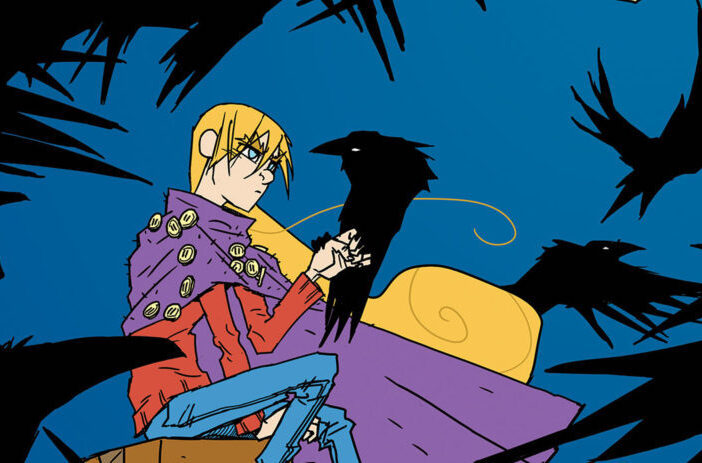
Review: ‘The Scarecrow Princess’
The Scarecrow Princess
Writer/artist: Federico Rossi Edrighi
Lion Forge; $15.99
Lion Forge’s Young Adult/teen imprint Roar has imported and translated Italian artist Federico Rossi Edrighi’s fantasy graphic novel The Scarecrow Princess, in which slightly surly teenager Morrigan Moore moves to a new town and finds herself swept up in an obscure harvest myth involving a cyclical battle between The King of the Crows and The Scarecrow Prince.
 The irony of her involvement is that she’s the one member of her family who couldn’t care less about the myth. She’s dragged to the rapidly gentrifying rural town by her mother and brother, a pair of famous fantasy writers who have come to research the local legend in hope of basing their next book on it. While they head immediately to the library, Morrigan has her hairpin stolen by a particularly bold crow, makes a friend, jumps the fence of a scary widow’s yard to retrieve her new friend’s lost bracelet, and ends up coming face to face with the town’s local, intimate expert on the King of Crows and the Scarecrow Prince.
The irony of her involvement is that she’s the one member of her family who couldn’t care less about the myth. She’s dragged to the rapidly gentrifying rural town by her mother and brother, a pair of famous fantasy writers who have come to research the local legend in hope of basing their next book on it. While they head immediately to the library, Morrigan has her hairpin stolen by a particularly bold crow, makes a friend, jumps the fence of a scary widow’s yard to retrieve her new friend’s lost bracelet, and ends up coming face to face with the town’s local, intimate expert on the King of Crows and the Scarecrow Prince.
ADVERTISEMENT
ADVERTISEMENT
That very night, the King himself visits her, and their conflict begins. She takes on the mantle of the Scarecrow Prince—quite literally, as it is a big, purple coat—and her assigned role in the destined drama. As it progresses, however, she gradually begins to question her role in it and whether or not she wants to be “special” if it requires sacrificing herself—not just her life, but her sense of self, her will, even her ability to control her own actions.
Edrighi’s story starts quite simply, with a modern-day character in a modern-day setting discovering a visually interesting cosmic battle between good and evil, as is more or less a genre standard, but the tale grows much more complicated before it reaches its resolution. Despite the supernatural forces at play, it is very much a humanistic take on myth.
Edrighi’s artwork is built out of strong, slightly jagged, even jittery lines, and his designs tend towards the highly stylized, but never at the expense of clarity. Regardless of how expressionistic his characters can look in terms of design, the world they move in and through is fully realized and as recognizable as the one outside your window…even if they are in a beautiful rural European village near the end of summer and the beginning of fall.
The King of Crows is presented as a handsome man in a black suit and tie from the mouth down, but where the top of his head should be there is simply an ever-shifting black mass of triangles and white eyes—there’s a huge flock of crows that is either attached to his brow like a flag or perhaps emanates from him as if the flock was smoke and he was a chimney. Their eyes act as his eyes, making his expressions and gaze hard to read beyond the shape of his mouth.
As for The Scarecrow Prince and/or Princess, the purple coat shifts shape quite fluidly. It is covered in buttons, and its sleeves can strike like snakes. It gradually starts to take over Morrigan’s body, so that she finds herself pulling strings out of the back of her head after wearing it and, eventually, becoming in danger of turning into an actual scarecrow.
Among her “powers” is the ability to command aspects of the town around her, and so furniture, sheets, and curtains become bizarre guardian creatures, as if they were draped over invisible monsters. By the final battle, she has turned the entire town into a giant made out of buildings, and it slugs it out with the King’s castle, while he and Morrigan confront each other withe weaponized crows and fabric.
It’s a pretty unique-looking comic, and the coming-of-age story its amazing artwork tells is just as unique.
Librarians should probably be warned that the book is geared towards older teens, and there are at least two passages that might prove potentially objectionable. There’s a scene where Morrigan appears to masturbate, which the King teases her about in a later encounter, and, near the end of the book, she doffs her sentient scarecrow coat, and is naked for a few pages (so too is the King, whose suit was destroyed in the battle). There’s nothing sexual in this particular encounter, and they are drawn in medium-to-long shots, but because people tend to respond to nudity when it’s drawn so much more powerfully than when it’s described in prose, the book might not be suited for every library.
Filed under: Graphic Novels, Reviews, Young Adult
About J. Caleb Mozzocco
J. Caleb Mozzocco is a way-too-busy freelance writer who has written about comics for online and print venues for a rather long time now. He currently contributes to Comic Book Resources' Robot 6 blog and ComicsAlliance, and maintains his own daily-ish blog at EveryDayIsLikeWednesday.blogspot.com. He lives in northeast Ohio, where he works as a circulation clerk at a public library by day.
ADVERTISEMENT
ADVERTISEMENT
SLJ Blog Network
Name That LEGO Book Cover! (#53)
Cover Reveal and Q&A: The One and Only Googoosh with Azadeh Westergaard
Fighting Public School Book Bans with the Civil Rights Act
Take Five: Middle Grade Anthologies and Short Story Collections
ADVERTISEMENT








